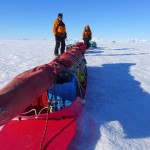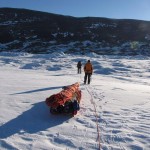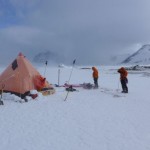Monday 5th November
We were dropped into Ablation Valley in the afternoon following a morning of waiting for a weather window. We finally departed around 4 pm following the arrival of the Dash-7 at 3:01 pm local time.
We had to wait for the Dash-7 to land as it was past PNR (Point of No Return) by the time the weather cleared. The Twin Otters are robust little planes (the Antarctic Landrovers) and are fitted with skis, so they can land almost anywhere flat. The Dash-7 on the other hand, lands on wheels, so can only land on blue-ice runways or gravel runways, like that at Rothera. Because there are not very many runways, once it is a certain distance from Sky Blu (the nearest blue-ice runway), nothing can take off or land on the runway, and it cannot be crossed by heavy vehicles, in case they break down and block it.

So, after a morning of hanging around, it ended up being a mad rush! However, we had a brilliant scenic flight in with our pilot, Al Howland. Tom Stroud (an old friend from my days at Durham University – what a small world it is!) was our co-pilot, and he kindly swapped so that I could sit up front. And while I was sitting there quietly trying not to touch anything (don’t distract the pilot), he started talking to me through my headphones, telling me what all the controls did – and then handed them over! So I flew almost the whole way to Ablation Point, except when I wanted to stop to take photographs. It is rather easy, a little like driving a car, although I only had to go in a straight line towards a point on the horizon, and everything beeps at you if you go too low or high.
We had a brief aerial tour of Ablation Valley, allowing us to take aerial photographs of our field site, and to see from above the lie of the land. We inspected the geomorphology, and the way into our field site through the pressure ridges.
We landed on skis on the ice shelf. Because it is unknown territory, the pilot first dragged his skis to check it out, and then circled back before landing in his tracks. The little twin otters come almost to a dead stop, and need hardly any space on a runway at all. We landed at about 1730, and after sorting out our kit and unloading the plane, we were left alone.
We loaded up the sledges just with essential survival kit, put on our harnesses, crevasse kit and crampons, and roped up as a three. Ian led the way with a massive sledge filled to the gunwhales. Mike was in the middle with a smaller sledge, and I was at the back with two smaller sledges. We began walking.
Crossing the flat ice shelf took about an hour of hard graft, until we reached the pressure ridges at its margin. Here the going became much harder. The route often had to be walked first to check for crevasses and a straight forward route with the minimum of up and down. The ridges and gullies made sledge towing challenging, with sledges often running away, falling over or getting stuck. Mike moved to the front to double-head Ian’s sledge, and I towed all three small blue sledges.
We arrived at our intended basecamp at about 10 pm. We put up our tent, the cosy three-man outfit, and were inside, warm and with tea by midnight. We went to sleep at about 1 am, after a long but exciting day.
Tuesday 6th November

Today was a camp day. We did another run to the depot, and finished making our tent. We could not manage our science kit as well, and we were all very tired after a long day yesterday. I had an even heavier load than yesterday, so was pretty well wiped out by the time we got back to the tent. However, we were quicker than yesterday – the walk in took 1 hour, the walk back 2.5 hours. It is about 4 km, and the snow conditions are not too bad.
It remains cold; below -20°C and with strong winds. However, the sun is strong and with an ozone hole, perfectly capable of penetrating the clouds, so we must all wear factor 50 sunblock and sunglasses. We all have running noses from the wind!

Our camp consists of one pyramid tent for sleeping, cooking and living, and one poo tent. Behind the poo tent we’ve set up a pee flag. We also have a radio with an antenna that comes out of our pyramid and extends for a few meters orthagonal to Rothera, and a freezer for luxury items – a large tub that we have buried deeply in the snow. It is filled with frozen vacuum-packed meals from Rothera, a little bacon and chicken, and other goodies (including hobnobs!). We have designated a place from which we will cut snow blocks for drinking water and built up a large supply.
The pyramid tent consists of three sturdy aluminium (surprisingly) which are dug into the snow. The guidelines are attached to large aluminium snow pegs, and the whole thing is stabilised by putting large blocks of snow on the valance. Our field medical box, kit bags, rucksacks, manfood boxes, radiobox and outside food box also go on the valance. When all this is accomplished, it makes a safe and sturdy living quarters.

Wednesday 7th November
This morning Ian and I made a quick dash to the depo for the final science kit, while Mike sorted things out at camp. We had light loads and were away less than 3 hours – back indeed for lunch! This was a packet of soup with pasta in it, biscuits brown and tinned fish.

After lunch I set up the differential GPS (Global Positioning System) base station. We will use this to obtain very accurate measurements of the heights of the moraines. After that, we went for a walk to inspect our local moraines. There was much to see and lots to look at. We also found some protalus ramparts and good boulders, which might be suitable for cosmogenic nuclide dating.
Back at camp at 1900 for some well-deserved man food (our boxes of field rations, with dehydrated Pack N’Go dinners. Just add water. Crunchy bits guaranteed).















